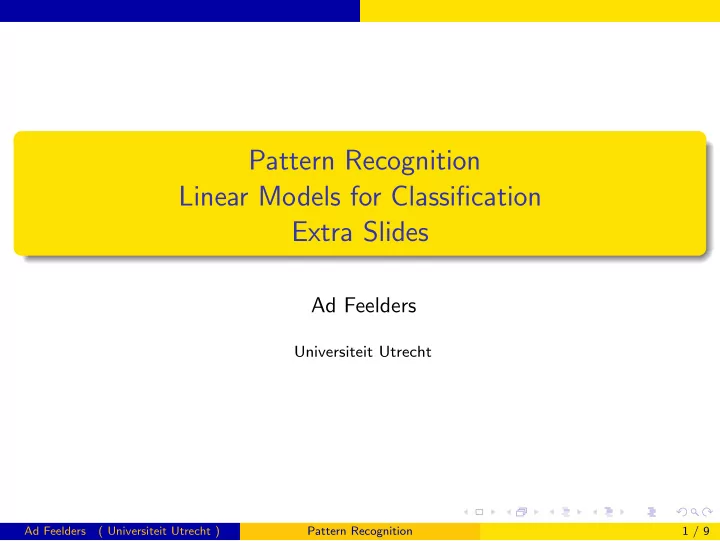

Pattern Recognition Linear Models for Classification Extra Slides Ad Feelders Universiteit Utrecht Ad Feelders ( Universiteit Utrecht ) Pattern Recognition 1 / 9
Maximum Likelihood Estimation: Coin Tossing Y = 1 if heads, Y = 0 if tails. β = Pr( Y = 1). In a sequence of 10 coin flips we observe y = (1 , 0 , 1 , 1 , 0 , 1 , 1 , 1 , 1 , 0). The likelihood function is ℓ ( β ) = β · (1 − β ) · β · β · (1 − β ) · β · β · β · β · (1 − β ) = β 7 (1 − β ) 3 The corresponding log-likelihood function is ln ℓ ( β ) = ln( β 7 (1 − β ) 3 ) = 7 ln β + 3 ln(1 − β ) Ad Feelders ( Universiteit Utrecht ) Pattern Recognition 2 / 9
Computing the maximum To determine the maximum we take the derivative and equate it to zero d ln ℓ ( β ) = 7 3 β − 1 − β = 0 d β which yields maximum likelihood estimate ˆ β = 0 . 7. This is the relative frequency of heads in the sample. Show that in general β = n 1 ˆ n , where n is the number of coin tosses, and n 1 is the number of times heads comes up. Ad Feelders ( Universiteit Utrecht ) Pattern Recognition 3 / 9
ML estimation for logistic regression In the logistic regression model, the probability of “heads” is assumed to depend on x in the following way: e β 0 + β 1 x Pr( Y = 1 | X = x ) = (1) 1 + e β 0 + β 1 x 1 Pr( Y = 0 | X = x ) = (2) 1 + e β 0 + β 1 x Given observations Y i and X i ( i = 1 , . . . , n ), if Y i = 1 then (1) enters into the likelihood function, and if Y i = 0 then (2) enters into the likelihood function. There is no closed form solution for the maximum likelihood estimates of β 0 and β 1 in this case. Except for some pathological cases, the likelihood function is concave, so there is a unique global maximum. Ad Feelders ( Universiteit Utrecht ) Pattern Recognition 4 / 9
Multinomial Logit in R # load training data > optdigits.train <- read.csv("D:/Pattern Recognition/Datasets/optdigits-tra.txt", header=F) # convert class label to factor > optdigits.train[,65] <- as.factor(optdigits.train[,65]) # same for test data > optdigits.test <- read.csv("D:/Pattern Recognition/Datasets/optdigits-tes.txt", header=F) > optdigits.test[,65] <- as.factor(optdigits.test[,65]) Ad Feelders ( Universiteit Utrecht ) Pattern Recognition 5 / 9
Multinomial Logit in R # load nnet library > library(nnet) # fit multinomial logistic regression model # column 1 and 40 are not used (always 0) > optdigits.multinom <- multinom(V65 ∼ ., data = optdigits.train[,-c(1,40)], maxit = 1000) # weights: 640 (567 variable) initial value 8802.782811 ... converged # predict class label on training data > optdigits.multinom.pred <- predict(optdigits.multinom, optdigits.train[,-c(1,40,65)],type="class") Ad Feelders ( Universiteit Utrecht ) Pattern Recognition 6 / 9
Multinomial Logit in R # make confusion matrix: true label vs. predicted label > table(optdigits.train[,65],optdigits.multinom.pred) optdigits.multinom.pred 0 1 2 3 4 5 6 7 8 9 0 376 0 0 0 0 0 0 0 0 0 1 0 389 0 0 0 0 0 0 0 0 2 0 0 380 0 0 0 0 0 0 0 3 0 0 0 389 0 0 0 0 0 0 4 0 0 0 0 387 0 0 0 0 0 5 0 0 0 0 0 376 0 0 0 0 6 0 0 0 0 0 0 377 0 0 0 7 0 0 0 0 0 0 0 387 0 0 8 0 0 0 0 0 0 0 0 380 0 9 0 0 0 0 0 0 0 0 0 382 Ad Feelders ( Universiteit Utrecht ) Pattern Recognition 7 / 9
Multinomial Logit in R # predict class label on test data > optdigits.multinom.test.pred <- predict(optdigits.multinom, optdigits.test[,-c(1,40,65)],type="class") > table(optdigits.test[,65],optdigits.multinom.test.pred) optdigits.multinom.test.pred 0 1 2 3 4 5 6 7 8 9 0 170 1 0 0 1 6 0 0 0 0 1 1 170 0 0 4 1 3 1 1 1 2 4 7 157 1 0 0 6 1 1 0 3 0 0 10 155 0 2 2 8 3 3 4 0 8 0 0 153 1 9 3 1 6 5 0 0 1 5 1 173 0 1 0 1 6 4 2 0 0 4 3 168 0 0 0 7 0 0 4 0 2 17 2 149 0 5 8 2 5 0 7 3 5 5 4 142 1 9 1 6 0 0 2 5 0 4 3 159 Ad Feelders ( Universiteit Utrecht ) Pattern Recognition 8 / 9
Multinomial Logit in R # make confusion matrix for predictions on test data > confmat <- table(optdigits.test[,65], optdigits.multinom.test.pred) # use it to compute accuracy on test data > sum(diag(confmat))/sum(confmat) [1] 0.888147 The accuracy on the test sample is about 89%. Ad Feelders ( Universiteit Utrecht ) Pattern Recognition 9 / 9
Recommend
More recommend